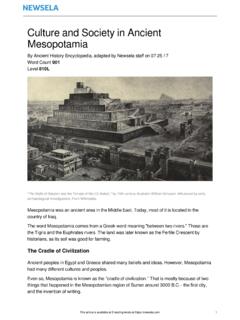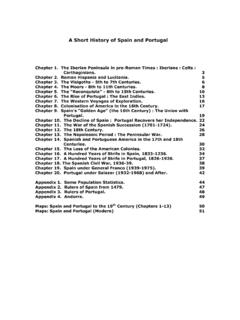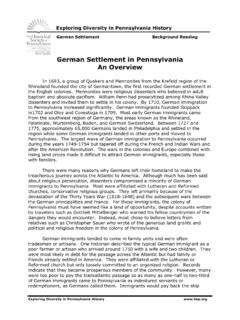Transcription of Open Educational Resources: Opportunities and Challenges
1 open Educational Resources: Opportunities and Challenges Dr. Jan Hyl n OECD s Centre for Educational Research and Innovation Paris, France Although learning resources are often considered as key intellectual property in a competitive higher education world, more and more institutions and individuals are sharing their digital learning resources over the Internet openly and for free, as open Educational Resources. The OECD s OER project asks why this is happening, who is involved and what the most important implications are of this development. In the following paper some preliminary findings are presented. The OECD/CERI study on OER There are many critical issues surrounding access, quality and costs of information and knowledge over the Internet as well as on provision of content and learning material. As it becomes clearer that the growth of Internet offers real Opportunities for improving access and transfer of knowledge and information from universities and colleges to a wide range of users, there is an urgent need to clarify these issues with special focus on open Educational Resources (OER) initiatives.
2 There is also a need to define the technical and legal frameworks as well as business models to sustain these initiatives. That is the background to the OECD/CERI study which aim to map the scale and scope of open Educational Resources initiatives in terms of their purpose, content, and funding and to clarify and analyse four main questions: How to develop sustainable costs/benefits models for OER initiatives? What are the intellectual property right issues linked to OER initiatives? What are the incentives and barriers for universities and faculty staff to deliver their material to OER initiatives? How to improve access and usefulness for the users of OER initiatives? ( ) What is OER? a conceptual discussion OER is a relatively new phenomenon which may be seen as a part of a larger trend towards openness in higher education including more well-known and established movements such as open Source Software (OSS) and open Access (OA).
3 But what is meant by open and what are the arguments for striving for openness? The two most important aspects of openness have to do with free availability over the Internet and as few restrictions as possible on the use of the resource . There should be no technical barriers (undisclosed source code), no price barriers (subscriptions, licensing fees, pay-per-view fees) and as few legal permission barriers as possible (copyright and licensing restrictions) for the end-user. The end-user should be able not only to use or read the resource but also to adapt it, build upon it and thereby reuse it, given that the original creator is attributed for her work. In broad terms this is what is meant with open in all three movements. It is also what is more or less covered in the definition used by The open Knowledge Foundation when they say that knowledge should be legally, socially and technologically open . ( ) The term open Educational Resources first came to use in 2002 at a conference hosted by UNESCO.
4 Participants at that forum defined OER as: The open provision of Educational resources, enabled by information and communication technologies, for consultation, use and adaptation by a community of users for non-commercial purposes. The currently most used definition of OER is: open Educational Resources are digitised materials offered freely and openly for educators, students and self-learners to use and re-use for teaching, learning and research. To further clarify this, OER is said to include: Learning Content: Full courses, courseware, content modules, learning objects, collections and journals. Tools: Software to support the development, use, re-use and delivery of learning content including searching and organization of content, content and learning management systems, content development tools, and on-line learning communities. Implementation Resources: Intellectual property licenses to promote open publishing of materials, design principles of best practice, and localization of content.
5 Although the most used, this definition needs further refinement. To start with it is not obvious what is meant by open . Walker defines open as convenient, effective, affordable, and sustainable and available to every learner and teacher worldwide and Sir John Daniel speaks of the 4 As: accessible, appropriate, accredited, affordable (Downes, 2006). Downes argues that the concept of open entails, it seems, at a minimum, no cost to the consumer or user of the resource and goes on: It is not clear that resources which require some sort of payment by the user whether that payment be subscription fees, contribution in kind, or even something simple, such as user registration, ought to be called open . Even when the cost is low or affordable the payment represents some sort of opportunity cost on the part of the user, an exchange rather than sharing. (Downes, 2006) He also argues that there is no consensus the term open should mean without restrictions as is apparent from the Creative Commons license, where authors may stipulate that use requires attribution, that it be non-commercial, or that the product be shared under the same license.
6 So while open may on the one hand may mean without cost , it does not follow that it also means without conditions . Furthermore the term Educational is not unambiguous. Does it mean that only materials produced with the intention of being used within formal Educational settings should be included? If so it would exclude resources produced outside schools or universities but used in formal courses, and materials produced inside such institutions but used for informal or non-formal learning outside. One alternative is to say that only materials actually used for teaching and learning should be considered. (OLCOS, 2006) The advantage with this option is that it avoids making an a priori stipulation that something is, or is not, an Educational resource . The disadvantage would be the difficulty to know whether a resource is actually used for learning or not, be it formal or non-formal learning settings. Finally it is also open to debate what the term resources should mean.
7 It is possible to distinguish between the type and the media of the resource . resource types might be courses, animations, simulations, games etc. and resource media might be web pages on the Internet, radio, television or paper. In this paper only digital resources will be considered although this limitation is not obvious in the general discussion on OER. The ambiguous situation regarding the conceptual issues is probably due to the fact that OER as a concept is still in its infancy. Earlier on the OA and OSS movements have had the same kind of often heated discussions regarding conceptual issues. The conceptual discussion is an important part of the OECD/CERI study and by the end of the project we hope to be able to present a more clear-cut definition. Mapping OER who is the user and the producer? It is still early days for the OER movement and at the moment it is not possible to give an accurate estimation of the number of on-going OER initiatives.
8 All that can be said so far is that the number of projects and initiatives is growing fast. Side-by-side with a number of large institution-based or institution supported initiatives; there are numerous small scale activities. Building on Wiley (2006) the following brief overview can be given over the OER movement in post-secondary education: Over 150 universities in China participate in the China open Resources for Education initiative, with over 450 courses online. 11 top universities in France have formed the ParisTech OCW project, which currently offers 150 courses. 9 of the most prestigious universities in Japan are engaged in the Japanese OCW Alliance that offers over 250 courses in Japanese and an additional 100 in English. 7 universities in the United States have large scale OER programmes (MIT, Rice, Johns Hopkins, Tufts, Carnegie Mellon, and Utah State University). Altogether there are over 2 000 freely available university courses currently online.
9 And more OER projects are emerging at universities in Australia, Brazil, Canada, Hungary, India, Iran, Ireland, the Netherlands, Portugal, Russia, South Africa, Spain, Thailand, the UK, the US, and Vietnam. There are also several translation efforts underway to broaden the impact of OER initiatives. These include Universia s Spanish and Portuguese translations and China open resource for Education s simplified Chinese translations and the traditional Chinese translations by OOPS. Universities in South Korea and Thailand are also considering launching additional translation projects. The number of non-course OER available increases rapidly as well. Rice s Connexions project currently hosts over 2 800 open learning objects available for mixing and matching into study units or full courses. MERLOT offers almost 15 000 resources, European based ARIADNE offers links and federated searches in several networks and repositories.
10 Textbook Revolution contains links to hundreds of freely available, copyright-clean textbooks. Freely accessible encyclopaedias like Wikipedia and Math World grow in size and quality. UNESCO/IIEP hosts a Wiki called OER useful resources listing several other portals, gateways and repositories. Even more difficult than to list the number initiatives would be to estimate the quantity of available resources, even with a narrow definition of OER. On top of resources accessible through initiatives like the ones listed above, it can be estimated to be far more resources available by way of search engines like Google or Yahoo!. What can be offered is a draft of a typology of different repositories. As already mentioned, there are both large scale operations and small scale activities. It is also possible to distinguish between different providers institution based programmes and more community based bottom-up initiated activities, which will be more discussed later in this paper.













